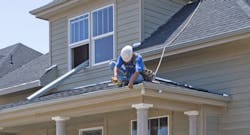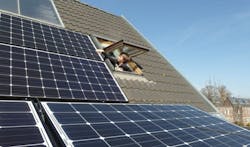Transitioning to Building Net Zero Homes? Start With Land Acquisition
Deciding to build net zero or net-zero energy ready homes requires changes to every aspect of your home building business, from land deals to warranty service. This monthly series is designed to provide practical and proven strategies to ease that transition. Please check back every month for the latest installment.
Step 1 in Building Net Zero Homes: Land Acquisition
While there are several proven strategies to reduce a home’s energy load and enable the most cost-effective and efficient renewable resource (such as residential solar panels or wind turbines), the process really begins with land selection and planning.
When builders acquire land to build net zero (or net-zero energy ready) homes that require an on-site energy source, several significant issues come into play.
For instance, is the local utility willing and equipped to pay or give credit to homeowners for surplus solar-generated power supplied to the local power grid through a renewable energy resource (solar or wind), a practice known as net metering? If not, more costly on-site storage or surplus electricity, namely batteries, could derail the pro forma.
"For us to build net zero homes, we need to be in a location that offers net metering," says Gene Myers, founder and CEO of Thrive Home Builders, in Denver. "In Colorado, some municipalities don't offer that, and it's not economically feasible to get to zero without it."
In effect, net metering draws hard boundaries that determine what gets built where. In the Denver area, Myers says, the local utility Xcel Energy allows net metering, but a rural electric cooperative that operates in the southern section of the metro area does not, which means Thrive won't build net zero energy homes there.
RELATED
But, the builder will likely offer net-zero energy ready homes, a compromise, of sorts, that essentially enables homeowners to add on-site renewable energy generation later, when the utility catches up or the owners have the budget to do so. Thrive builds approximately 30 to 40 true net zero homes per year, and the rest (a couple hundred per year) are net zero ready.
Solar Fit Is Secondary When Building Net Zero Homes
Builders and developers also need to consider whether the land acquisition and development costs still pencil out when they add the premium of building to a net-zero energy standard. "Our effort is first and foremost to find land that's reasonably priced and well-located such that we can have a competitive home price and attractive location for customers," Myers says.
Cost also is a key factor in land acquisition decisions for Garbett Homes, a net-zero builder in Salt Lake City. Company spokesman Jon Nieporte says as much as 10% of land deals the company considers may be ruled out because the added cost of building to the U.S. Department of Energy’s Zero Energy Ready Homes (ZERH) standard puts the deal out of the sweet spot where it makes sense financially.
"We will walk away from otherwise buildable land if we can’t build to our ZERH standards and be successful," Nieporte says.
In some cases, a different product type may result in a viable solution. Rather than build one 1,800-square-foot detached residence, for instance, Garbett may look at other options, such as duplexes, townhomes, or rental units. If none of the alternates pencils out with the ZERH components, the land deal doesn't move forward.
Tree Removal Solves Shady Lot Issues
Net zero neophytes may wonder whether existing, mature trees that provide shade are a consideration in land acquisition decisions for net zero homes. Steve DeCleene, president of Neumann Developments, in Pewaukee, Wis., says the answer is generally moot because trees usually are removed, regardless of the type of project being built.
Marcie Geffner is a freelance reporter specializing in real estate and banking. She lives in Ventura, Calif.

